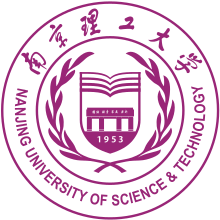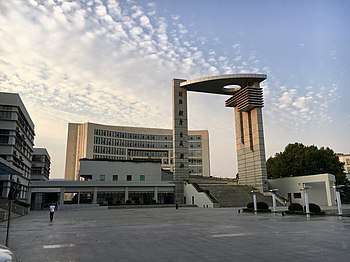Nanjing University of Science and Technology
Nanjing University of Science and Technology (Chinese: 南京理工大学; pinyin: Nánjīng Lǐgōng Dàxué), colloquially NJUST (南理工; Nánlǐgōng) is one of the national key universities under the Ministry of Industry and Information Technology of China. It is a science-oriented university located in Xuanwu District in the east suburban area of Nanjing.
南京理工大学 | |
 | |
Former name | Artillery Engineering College of the PLA (炮兵工程学院); East China Institute of Engineering (华东工程学院); East China Institute of Technology (华东工学院) |
|---|---|
| Motto | 进德修业 志道鼎新 |
Motto in English | Enhancing moral characters, Delving into knowledge, Seeking truth, Innovating |
| Type | Public |
| Established | 1953 |
| President | FU Mengyin (付梦印)[1] |
| Vice-president | QIAN Linfang, WANG Lianjun, LIAO Wenhe and CHEN Qian[1] |
Academic staff | 1,900[2] |
| Students | 30,000[3] |
| Address | 200 Xiaolingwei Street, Xuanwu District , , , 210094 , China |
| Campus | Suburban |
| Colors | Purple |
| Website | www |
 | |
History
Nanjing University of Science and Technology can be traced back to 1952, as Department of Artillery Engineering of Institute of Military Engineering of the PLA in Harbin. Since its establishment, it aims on serving national strategies and promoting social progress. In 1962, the campus moved to Nanjing. The name of the university changed many times, and finally determined as current name in 1993. In September 1998, the name on the school badge was inscribed by Chinese President and General Secretary of the Communist Party Jiang Zemin.[4] In June 2008, Nanjing University of Science and Technology is subordinated to the Ministry of Industry and Information Technology.
Evolution of Nanjing University of Science and Technology since 1953 | |||||||||||||||||||||||||||||||||||||||||||||||||||||||||||||||||||||||||||||||||||||||||||||||||||||||||||||||||||||||||||||||||||||||||||||||||||||||||||||||||||||||||||||||||||||||||||||||||||||||||||||||||||||||||||||||||||||||||||||||||||||||||||||||||||||||||||||||||||||||||||||
|---|---|---|---|---|---|---|---|---|---|---|---|---|---|---|---|---|---|---|---|---|---|---|---|---|---|---|---|---|---|---|---|---|---|---|---|---|---|---|---|---|---|---|---|---|---|---|---|---|---|---|---|---|---|---|---|---|---|---|---|---|---|---|---|---|---|---|---|---|---|---|---|---|---|---|---|---|---|---|---|---|---|---|---|---|---|---|---|---|---|---|---|---|---|---|---|---|---|---|---|---|---|---|---|---|---|---|---|---|---|---|---|---|---|---|---|---|---|---|---|---|---|---|---|---|---|---|---|---|---|---|---|---|---|---|---|---|---|---|---|---|---|---|---|---|---|---|---|---|---|---|---|---|---|---|---|---|---|---|---|---|---|---|---|---|---|---|---|---|---|---|---|---|---|---|---|---|---|---|---|---|---|---|---|---|---|---|---|---|---|---|---|---|---|---|---|---|---|---|---|---|---|---|---|---|---|---|---|---|---|---|---|---|---|---|---|---|---|---|---|---|---|---|---|---|---|---|---|---|---|---|---|---|---|---|---|---|---|---|---|---|---|---|---|---|---|---|---|---|---|---|---|---|---|---|---|---|---|---|---|---|---|---|---|---|---|---|---|---|---|---|---|---|---|---|---|---|---|---|---|---|---|---|---|---|---|
| |||||||||||||||||||||||||||||||||||||||||||||||||||||||||||||||||||||||||||||||||||||||||||||||||||||||||||||||||||||||||||||||||||||||||||||||||||||||||||||||||||||||||||||||||||||||||||||||||||||||||||||||||||||||||||||||||||||||||||||||||||||||||||||||||||||||||||||||||||||||||||||
Academics
Nanjing University of Science and Technology is a multi-disciplinary university, comprising academic fields including science, engineering, liberal arts, economics, business, management, law and education. In addition, it encompasses a wide array of centers, institutes, programs, and administrative support offices. It carries on its education and research on both undergraduate and postgraduate levels in 15 schools, led by a total of 70 undergraduate majors, 116 master programs and 49 doctoral programs, and 14 Post-doctoral research stations.
Project 211, 985 and Double First Class University Plan
Nanjing University of Science and Technology has become a National Key University of Project 211 in 1995. In 2000, Ministry of Education approved NJUST to start the graduate school. Later in 2011, the university is authorized to build 985 Advantage Discipline Innovation Platform.[3]
In September 2017, Nanjing University of Science and Technology is included in Double First Class University Plan of Ministry of Education , with Double First Class Discipline status in "Weapon Science and Technology" Discipline.[5]
Schools and Departments
In June 2018, Nanjing University of Science and Technology has these colleges or schools:
- School of Mechanical Engineering
- School of Chemical Engineering
- School of Electronic Engineering and Optoelectronic Technology
- School of Computer Science and Technology
- School of Economics and Management
- School of Energy and Power Engineering
- School of Automation
- School of Science
- School of Foreign Studies
- School of Public Affairs
- School of Materials Science and Engineering
- School of Environmental and Biological Engineering
- School of Design and Communication
- Tsien Hsue-Shen College[6]
- School of Intellectual Property
- School of Marxism
- School of International Education
- School of Continuing Education
- Sino-French Engineer School
- Zijin College
- Taizhou Institute of Science and Technology
- Graduate School
Campus
Different from many universities in Nanjing, Nanjing University of Science and Technology has only one main campus based in Xiaolingwei, Xuanwu District, on the south of the Purple Mountain and Dr. Sun Yat-sen's Mausoleum.[7] It covers a total area of 3,118 mu[lower-alpha 1] (207.87 ha).[3] Undergraduates and graduate students of shares the same main campus.

In 1998, Zijin College of NJUST founded in Xianlin University City, Nanjing.[8] In June 2004, Taizhou Institute of Science and Technology founded in Taizhou, Jiangsu, as a branch institute of Nanjing University of Science and Technology.[9]
Notable alumni
- 潘德炉, leading researcher of ocean color remote sensing in China, CAE member
- 李鸿志, CAE member
- Wang Zeshan, CAE member
- 刘怡昕, CAE member
- 陈志杰, CAE member
- Ren Xinmin, aerospace engineer and specialist in astronautics and liquid rocket engine technology, CAS member
- 邢球痕, solid rocket motor scientist, CAS member
- Lu Ke, material scientist, CAS member
- 崔向群, astronomer, CAS member
- 田禾, fine chemistry expert, CAS member
- 李应红, aeronautical propulsion theory and engineering expert, CAS member
- 芮筱亭, emission dynamics scientist, CAS member
- Lu Zhangong, Vice Chairman of the Chinese People's Political Consultative Conference
Notes
- mu (亩) is a Chinese unit of measuring area, 1 mu = 614.4 m² = 734.82 sq yd
External links
References
- "Administration".
- "Facts& statistics". english.njust.edu.cn.
- "学校简介". www.njust.edu.cn.
- 1998年9月,江泽民同志为学校亲笔题写了校名. sohu.com. 15 November 2013. Retrieved 15 August 2018.
- 教育部 财政部 国家发展改革委 关于公布世界一流大学和一流学科建设高校及建设 学科名单的通知. Retrieved 15 August 2018.
- "学院简介". qxs.njust.edu.cn.
- "Campus". english.njust.edu.cn.
- 紫金学院简介 (in Chinese)
- 学校简介 - 南京理工大学泰州科技学院. www.nustti.edu.cn.
